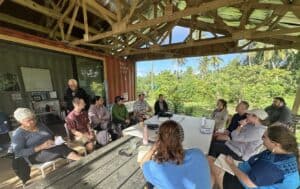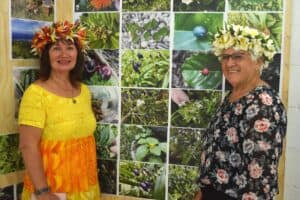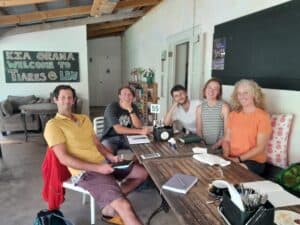Friday 4 October 2024 | Written by Supplied | Published in Environment, National
The inaugural Muri Environment Care Expo, concluding tonight, showcases the group’s efforts to preserve and protect their lagoon through ecological restoration activities.
Muri residents have passionately dedicated over a decade to preserve and protect their lagoon through the Muri Environment Care (MEC) community group.
This non-government-organisation (NGO) is devoted to advancing ecological restoration efforts through the development of a specialised plant nursery and experimental, local based specific restoration activities.
The Muri Environment Care is running an Expo this week from 9am to 7pm at the Avana Meeting House to promote its works and raise awareness. The Expo will conclude today.
The opening for the exhibition was held on Wednesday morning attended by Aronga Mana in the village, Pu Tapere for Muri Keta Williams, MP Tukaka Ama and community members.
Mii Kauvai, one of MEC’s founding members, says everyone is welcome to pop in, talk to the volunteer scientists assisting with the projects and ask questions.
<iframe src="https://www.facebook.com/plugins/video.php?height=314&href=https%3A%2F%2Fwww.facebook.com%2Fcookislandstelevisionnews%2Fvideos%2F520644164006046%2F&show_text=true&width=560&t=0" width="560" height="429" style="border:none;overflow:hidden" scrolling="no" frameborder="0" allowfullscreen="true" allow="autoplay; clipboard-write; encrypted-media; picture-in-picture; web-share" allowFullScreen="true"></iframe>“I feel very proud and very grateful that out of an idea from one of our members, Anne Tierney, who wanted to have this expo concentrating on Muri, to see the great turnout,” said Kauvai.
Tierney said that having a good crowd turn up was a real buzz to be involved in, and that there were different aspects in which they could improve.
“We really want to get some good projects going with our wonderful volunteer scientists and we wanted the community to meet them and talk to them,” she said.
“The main thing is we want to know more from the community.”
Pu Tapere for Muri, Keta Williams, a big supporter of the group, believes that there aren’t many locals involved in the project because they don’t fully understand what they are actually doing.
However, he adds that Muri as a whole understands what’s being tried to be done and people have allowed their lands near streams to be planted to help stop erosion.
“We’ve really just been concentrating on Muri as we don’t want to take on Ngatangiia as a whole as it’s too wide, too big, and too many critics,” Williams added.
MEC’s head ecologist Brennan Panzarella has been with the project for three years, growing native plants from seeds for its thriving plant conservation nursery, riparian and coastal restoration efforts.

Ecologist Brennan Panzarella, right, chats to Liana Scott, general manager of the Muri Beach Club Hotel. MELINA ETCHES/24100309
Panzarella prefers to grow plants from its seeds.
“From seeds you actually get genetic diversity, from cuttings you get a clone,” he said.
“When you have seeds you have the ability for them to have more resilience into the future whereas if you’re cloning the same one then there’s more chance that they will all fail at the same time.
“So, when you want diversity and biodiversity you want genetic diversity as well and to preserve genetic diversity, locally sourced seeds is the best way to preserve genetic diversity.”
Panzarella says that while he tries to stick to seeds exclusively, it’s much more challenging
Ric Balfour, the Waikato Catchments Coordinator from New Zealand, is also assisting MEC.

According to Balfour, the biggest problem in many of the streams in New Zealand is that when there is a lot of heavy land use, it affects the stream quality, which then affects the water, drinking water and other uses. He adds that this ultimately affects downstream and the lagoon.
“In New Zealand, we’ve built up a way of understanding what is happening to our streams, what can we monitor and what we can measure and how can we make sense of that information.”
Balfour’s task involves $10,000 worth of donated equipment, which has four kits to test the water quality in the streams and lagoon.
He said this testing filter captures all organisms and DNA, providing a list of all the species captured in that filter to give a clear picture of the organisms living in that stream.
The final day of the Expo opens at 9am today. Tonight’s discussion will be on “Protecting Muri’s wetlands and streams”, featuring Sam Napa at 5pm.



